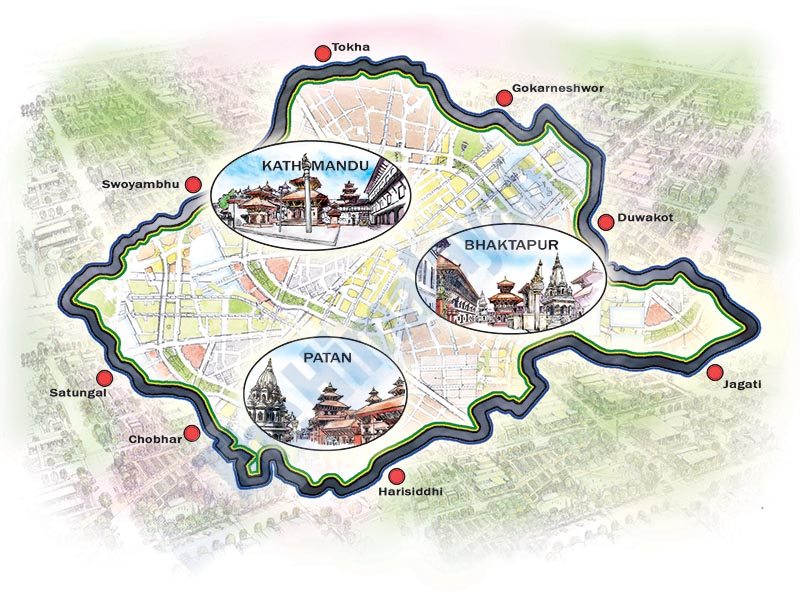Outer Ring Road: Heading for a limbo
A project which has already consumed 300 million rupees for its study cannot just be wished out of existence. There should be firm ground for taking such a step. It should be proved that the project is economically or functionally not feasible
It has been learnt that the government has not allocated budget for the construction of the 72-km-long Outer Ring Road in the forthcoming fiscal year.
This has come as a shocking surprise to the people of Nepal, in general, and those of the Kathmandu Valley, in particular. There are several reasons contributing to this state of affairs.
Firstly, a ring road has been an indispensable feature of cities round the globe. It provides an image to the city and makes it memorable by creating pathways, nodes and landmarks by its sides. This can be crystal clear from the eight ring roads that encircle Beijing, the capital of our northern neighbour, China. New Delhi has been enjoying the service of two ring roads since a long time now. Most of the third ring road has already been constructed.
The remaining part will be completed as soon as the land acquisition problem is solved.
Secondly, ring roads are essential because they ease traffic congestion, which has assumed an alarming proportion in the city core, particularly in Kathmandu and Lalitpur. Thirdly, they also provide the much-needed connectivity to the peripheral areas.
The Outer Ring Road seems to be heading towards uncertainty like the Melamchi Water Supply Project in Nepal. The expectation so far was that the Outer Ring Road would be constructed at all cost. It will not only tone down the traffic congestion but also bring down the ever increasing pollution. It was also expected to link the central core to the outlying areas. It is for this reason that countries round the world have been virtually mesmerised by the ring roads.
Croatia very recently took this initiative to construct one ring road in Galway city. Nearer down south, the flamboyant cine city of Pune has also embarked on a plan to construct a new ring road.
The history of the ring roads goes a long time back in the past. Panchari in his Arthashasthra, composed around early fourth century BC, had recommended for three east-west and three north- south roads for the planning of cities.
This mode of planning would eventually lead to the implicit emergence of two ring roads - one at the city’s centre and the other in its peripheral areas.
China is streets ahead of the other countries when it comes to the construction of ring roads. Its construction of eight ring roads in Beijing is simply overwhelming.
Whilst the first ring road emerged during the time of the Cultural Revolution in the mid-Sixties, the other seven followed in quick succession just within three decades. Nepal’s first ring road was built by China in the Seventies. It provided a fillip to the extension of the city. Due to its multifaceted benefits, an outer ring road was proposed more than a decade back. It has been reported that more than 300 million rupees has been spent in carrying out the necessary studies.
Land pooling was proposed to arrange for the necessary land for the construction of the road. This technique has been successful in many sectors, such as housing as well as disaster risk reduction.
Libali land pooling is one of the glaring examples, which has been undertaken for housing in Bhaktapur.
Similarly, land pooling was emulated in the post-disaster reconstruction after a fire engulfed the town of Myanglung in east Nepal. It is very surprising that the government has not been able to derive benefits from this tool, which has been tested several times for its efficacy.
The pretext provided by the concerned ministry is its high cost. It has been reported that this ring road will cost Rs 213 billion, when the total development budget is about Rs 300 billion only. This is nothing less than an eyewash.
When Parthenon was constructed in Athens, Greece, that too way back in fifth century BC, it cost 400 talents, then the Greek unit. That time the revenue of the state was a mere 500 talents. But King Pericles continued with the project by engaging sculptors like Phidias and architects like Ictinus and Callicrates.
Today, tourists from all around flock to Athens just to catch a fleeting glance of this great temple. This road is also likely to attract tourists because of its alignment through some breathtakingly beautiful spots.
A project which has already consumed 300 million rupees for its study cannot just be wished out of existence. There should be firm ground for taking such a step.
It should be proved that the project is economically or functionally not feasible.
But this is not at all the case in view of four companies showing interest to invest during the recently concluded Nepal Investment Summit.
The first ever two-thirds majority communist government of Nepal has committed itself to the creation of a prosperous Nepal and happy Nepalis. But the government seems to be busy in delivering mere sweet nothings to the people. The drafting of the controversial Media Council Bill, centralisation of all the powers in the Office of the Prime Minister, use of indecent language in the Federal Parliament and failure to bring the murderer of Nirmala Panta to book have in no way enhanced the image of the government. The forceful abortion of such important projects without any rhyme or reason may further impair the government’s image beyond a state of repair.






